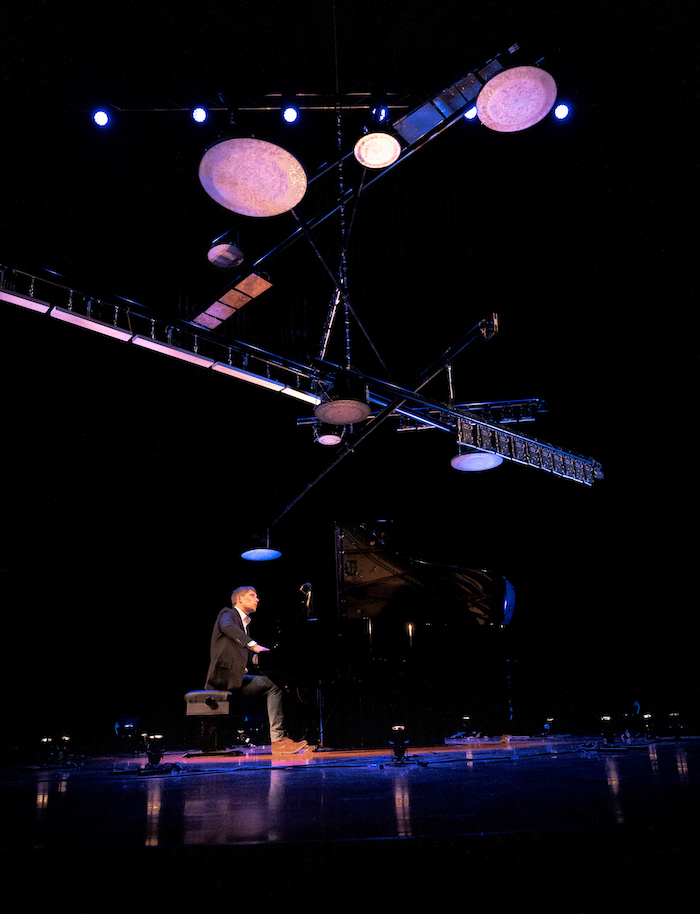A visual representation of John Cage’s groundbreaking master work is a meditative journey through sound and emotion, writes Penny Shaw.
Sound and sculpture sync in new dimension
4 March 2023
- Reading time • 5 minutesMusic
More like this
- Rewriting tradition with skill and charm
- Close encounter stirs the soul
- The great unknown
The Cage Project, Matthais Schack-Arnott & Cédric Tiberghien
Perth Concert Hall, 3 March 2023
Even after a thorough reading of the program notes, I admit I still had little idea what to expect from Perth Festival’s world premiere of The Cage Project.
It is billed as a three-dimensional reimagining of John Cage’s Sonatas and Interludes, a 1948 work that is credited with forever changing what is possible from a piano.
On entering the Perth Concert Hall auditorium, we see a grand piano in the stage spotlight over which is suspended a huge, industrial-looking mobile, as if preparing to spray the stage with pesticide. Given Cage’s reputation as an “enfant terrible” of the classical music world, anything seems possible.
As pianist Cédric Tiberghien enters the stage there is a hushed excitement from the audience. Before playing, he explains that this piano is no ordinary instrument, that it has been “prepared” according to Cage’s exact instructions, with materials including screws, bolts, bits of rubber and plastic placed with precision on the strings. This means that, along with the familiar melodic piano tones, we will also hear some unusual percussive noises. He reassures us that, although this may be confronting at first, as the piece progresses through the eight permanent emotions, according to Indian aesthetic theory, we should end up at the ninth – tranquillity.

The Cage Project is the brainchild of Musica Viva artistic director Paul Kildea who was so inspired by Australian artist and percussionist Matthias Schack-Arnott’s 2019 debut of Everywhen, he approached him about working on a response to Cage’s 1948 masterpiece. Schack-Arnott in turn took his inspiration from visual artist Richard Lippold, to whom Cage dedicated two of his sonatas. Cage had some of Lippold’s metal and wire mobile sculptures hanging in his apartment and these provided the vision for The Cage Project.
It is an ambitious undertaking to add further to an innovative work of avant-garde music that already pushes the boundaries of what is possible with traditional instruments. The result is a deeply introspective and meditative work which invites the audience to explore new and thought-provoking territory.
Tiberghien’s prepared piano is also a MIDI keyboard, a computerised electronic instrument where each of the 45 prepared notes is linked to a corresponding sound object on the suspended structure. Unfamiliar as I am with the usual rendering of this music, it is hard to tell which sounds emanate from the prepared piano and which from the hanging sculpture but after a while I stop trying to analyse it and allow myself to become immersed.
Visually it evolves in symmetry with the music; the arms of the giant sculpture begin to rotate, lit first from below and then also from the side, casting eerie shadows. The lighting changes, brilliantly conceived and implemented by Keith Tucker, and the robotics systems, designed by Nick Roux, are also triggered by the keyboard, making them seamless additions to Tiberghien’s expressive touch.
The eight emotions we should be cycling through are the heroic, the erotic, the wondrous, the comic, sorrow, fear, anger, and the odious. I can’t say that I experience all of them.
However, by the end of the piece, as the stage fades to darkness, leaving only twinkling lines of red and green, I am reminded of hot nights swimming at South Beach, the phosphorescence glimmering as I move my limbs, watching the far-off flashing in the Fremantle shipping lanes. I realise that, unlikely as it seems, I have indeed arrived at my own personal place of tranquillity.
Pictured top: Cédric Tiberghien takes his audience on a journey through the emotions. Photo: Tony McDonough
Like what you're reading? Support Seesaw.






